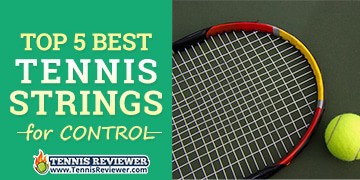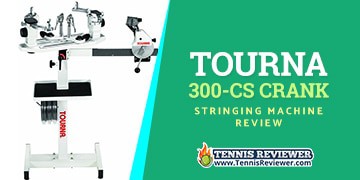Apart from mastering the game of tennis itself, there’s a multitude of gear and equipment available to help players reach their potential. In addition to the many possible racket customizations, the string tension is one of the factors that directly influence gameplay.
Just like selecting the right string material, knowing the optimal tension for your racket ultimately comes down to your style of play and level of experience. If you play consistently, you’re likely to notice when the response of each hit feels different than usual. If it doesn’t feel right, that’s usually a sign that the strings need to be examined, tightened, or replaced altogether.
The string tension of a racket is usually measured in pounds, and most rackets have a recommended string tension between 50 and 70 pounds. One great approach is to check on the inside of your tennis racket’s throat, and you should see the manufacturer recommendation for tension. Some players may want to string slightly above or below the recommendation. One other good option is to start in the middle of the recommendation then work up or down, depending on response during play.
For example, if your racquet says the recommended string tension is 55 lbs – 60 lbs, start with 58 lbs and see how it feels. Based on the performance of the racquet and overall feel, you can adjust the tension higher or lower based on your preference. It may take a few times to dial in your favorite tension. However, if you start in the middle, you should be able to find a string tension you like pretty quickly.
A loosely strung racket will usually have a more prominent sweet spot and will hit further. A tightly-strung racket, on the other hand, will offer more control but will require more force behind each stroke to deliver the same power.
Overall, string tension has a tangible effect on gameplay, which the player can register from the first serve on throughout the rest of the game. It would be best if you considered tension as it pertains to your style of play and think about which configurations work best for you.
Table of Contents
Loss of Tension with Time
Due to the tension present in the strings, elasticity and tension begin to diminish the moment they are installed in a racquet. “Dead strings,” or strings which have lost their tension, cut down on the performance of a racquet. Dead strings may also hamper a tennis player’s ability to generate power and pace, and may even make their arm sore.
As an illustration of the effect of time on tension, sometimes experts cite the example of professional players who ensure that their rackets are strung on the day of a match to ensure that minimal tension is lost before it’s time to play at a high level.
Storage of the racket will also affect tension. Excessive heat or cold and whether a racket bag is used will negatively affect stringing, and differences because of this will be even more noticeable to the seasoned player.
Effects on Gameplay & Determining the Right Tension
For some pros, it makes sense to have access to a string tension meter which can much more precisely measure the loss of tension in strings, in which case the player may want to restring after they measure a loss of 25% or more in stringbed stiffness. Overall, we suggest rules of thumb like the days per week to times per year one, but ultimately good players approach the game with mindfulness that keeps them aware of racket feel.
On the other hand, stiff, well-tensioned stringing can give your strikes the pop they need to reach the opponent with force. When you tap your fingers on a set of fresh strings, you should hear a “ping.” Dead strings will sound like a softer “thud.” When you don’t hear that clean ping, it’s usually a sign that it’s time to restring.
Stiff or High-Tension Stringing
A tightly-strung racket may make it more difficult for the player to “feel” the ball but can give you good control if swung hard enough, with a smooth follow-through. High tension may increase the difficulty of higher-finesse, delicate shots, but allows more consistent play from the baseline. Lastly, high-tension string configurations can more easily tire the arm.
The stiffer or more rigid the strings, the more responsive the ball will be to the player’s actions. Loose strings will tend to absorb more of the momentum of an incoming ball and require a bigger hit in response to keep up the same velocity.
Loose or Softer Stringing
Generally speaking, a lower string tension will provide a player with more power, and a higher tension will provide a player with more control.
With a lower tension or softer string bed, your strings will tend to function as a trampoline. Making contact with the ball, then giving it some leeway to rebound, just like an object or person on a trampoline. Therefore, when a tennis ball comes in contact with your strings, the rebound effect will be more significant. This provides you with the ability to generate more speed or power on your shots. However, it’s sometimes more difficult to precisely direct the ball, that is, make it fly precisely where intended.
Considering Different Materials When Determining Tension
Strings made of natural gut, one of the original materials used to make tennis strings, do a good job of maintaining tension because of natural elasticity. In addition to this, they have a very subtle texture that allows for better grip on the ball and slight friction that allows better control and ability to manipulate spin during play better. For natural gut strings, maintaining a favorable feel and tension is attainable. However, the strings of this material wear more quickly and thus will need to be replaced more often.
Unfortunately, heat and weather conditions will adversely affect string tension for natural gut materials. That said, if you notice less responsive play from your natural gut-strung racket, it may be because of temperature or weather conditions as opposed to strings that are overworn and in need of replacement.
Nylon strings, one of the most common options, are much more durable than natural gut strings, and hold tension longer because of increased resistance to wear.
Kevlar stringing has a considerably stiffer feel. As a result, you may want to this type of string at a tension that is approximately 5-10% lower than what you usually string nylon strings. The lower tension will help offset the added stiffness of a kevlar string.
On the other hand, if you were to move from a nylon string to a polyester string you may want to string your racquet 5-20% lower because most polyester strings will tend to perform better at lower tensions. Just keep in mind that polyester strings are known for stretching and losing some of their tension when first being strung so you may want to adjust for that slightly too.
In general, the recommended level of tension will vary depending on material type, as they act differently under a load. Be sure to note and follow the instructions that come with your strings, and install them according to the tension rating (in pounds) that they indicate.
Different types of strings will have a dramatically different feel at the same tension. For example, if you were to string your racquet at 55 lbs with a nylon string, and then switch to a kevlar string and use the same tension, it will become clear how different they feel and play.
Final Thoughts
When you’re first getting started, it can be difficult to register slight variations in string tension simply by referencing the tension poundage because you won’t have any meaningful point of reference. Only until you’ve had the opportunity to play with a single racquet strung at more than one level of tension will you begin to appreciate and understand the feel of a particular tension and get a sense of how it will affect your personal style of play.
In a nutshell, the desired level of tension in a racket depends on the personal preferences of the player. It’s tough to make a definitive recommendation or decision about tension without having played extensively, experimented with different styles and paces of play, as well as understood the other multitude of options for racket customization (length, size, weight, etc.). The best course of action is to keep an open mind when playing and be mindful of the way different string tension configurations feel against the ball. This is the best way to be an informed consumer as well as a savvy player.











